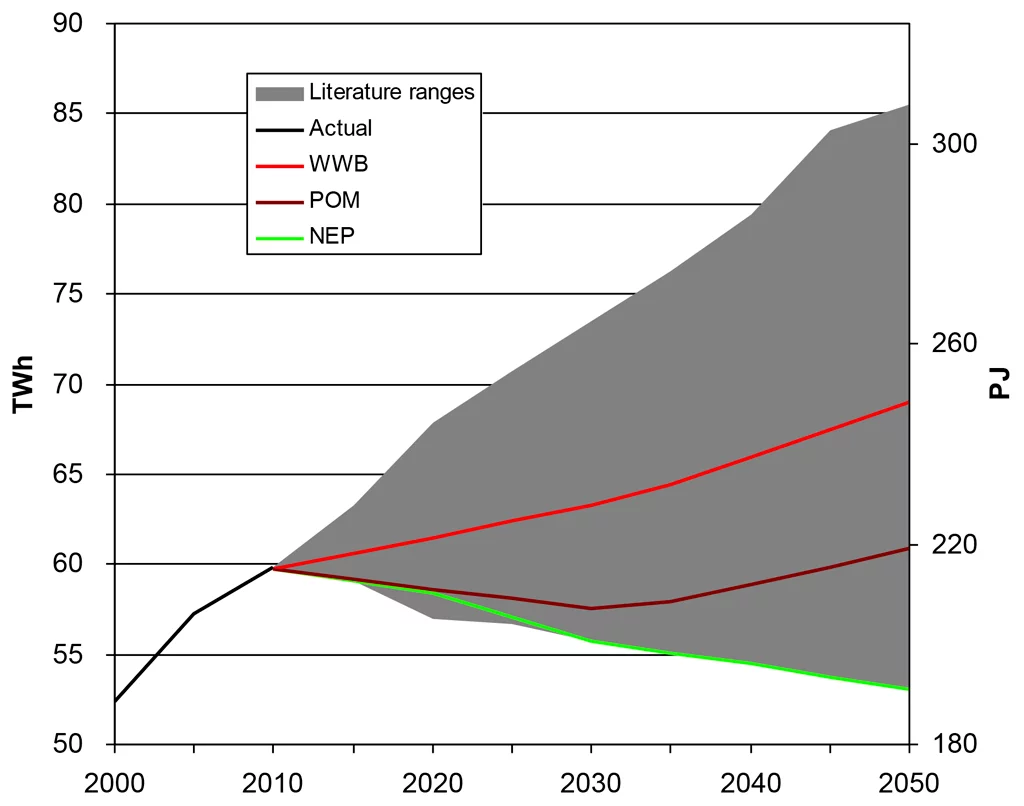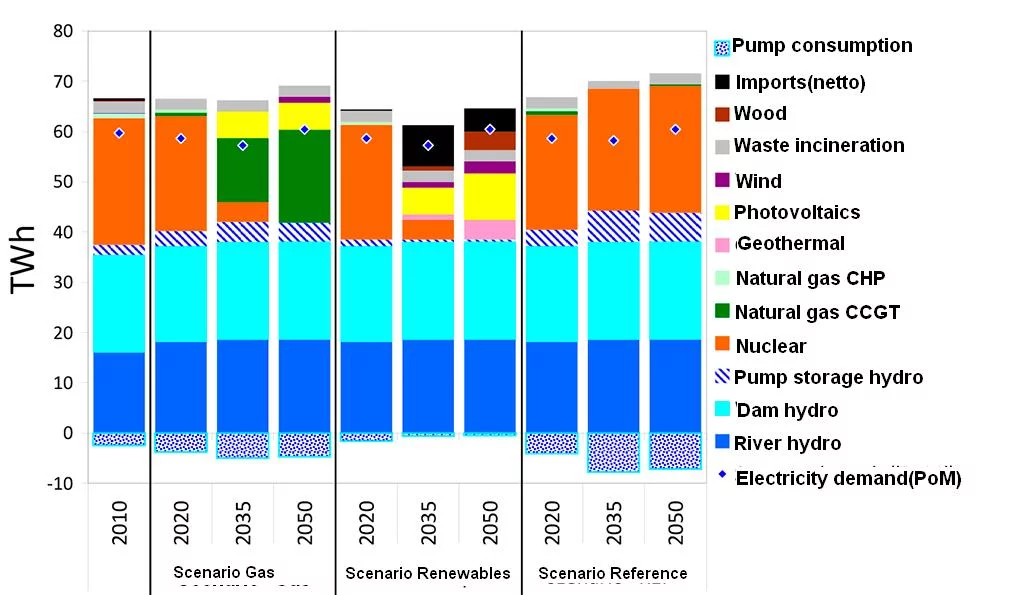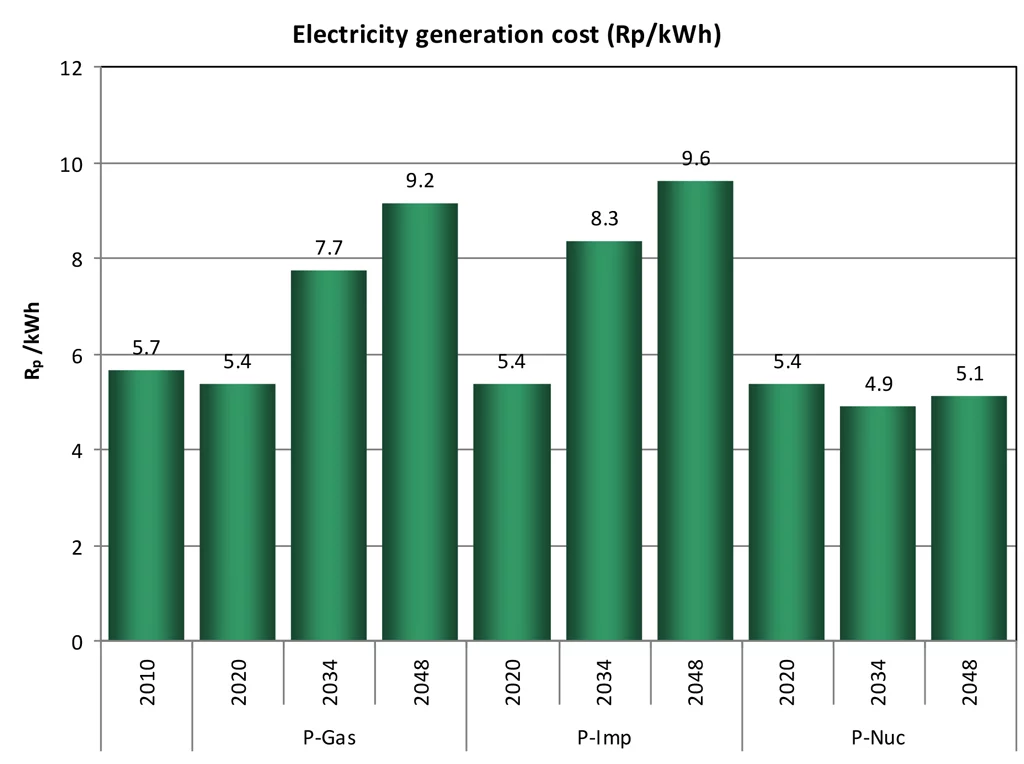Researchers in the Energy Economics Group at the Paul Scherrer Institute PSI have used their model of the Swiss electricity system—STEM-E model—to analyze various electricity supply scenarios. They have concluded that alternatives to today's electricity supply are associated with different costs, risks and opportunities. Realising sustainability objectives such as climate protection while phasing out nuclear generation and making Switzerland's electricity supply independent of foreign countries raises many challenges. Under these circumstances the analysis by the PSI scientists suggests that costs of electricity production are likely to increase by at least 50 percent by 2050.
The future of the electricity system in Switzerland will depend on many factors. These include the availability and cost of new technologies such as solar and wind power plants, the policy goals in terms of reducing greenhouse gas emissions, the opportunities to trade electricity with neighbouring countries, and future demands for electricity. Many of these in turn depend on uncertain factors that are hard to predict like economic and population growth, technological developments and future policy choices. The analysis at PSI seeks to identify the implications of these uncertain factors for future electricity supply options. Based on various studies future electricity demand in Switzerland could be anything between 53 and 85 TWh by 2050 compared to 60 TWh of today (see graph). This wide range illustrates the extent of the uncertainty regarding future demand. Within this range, the three latest scenarios of the Federal Government are highlighted in the graph. These scenarios comprise:
• A Business As Usual (BAU) scenario in which electricity demand rises steadily up to 2050.
• A Policy Measures (PoM) scenario that assumes the successful implementation of the technology and energy efficiency measures announced in the Energy Strategy 2050. In this scenario, electricity demand declines marginally in the next two decades and then increases.
• A New Energy Policy (NEP) scenario with increased and internationally harmonized efficiency measures, leading to a decline in electricity consumption of around 10 percent between today and 2050.
The researchers at PSI have focused on the Federal Council’s demand scenarios in their analysis of electricity supply options.
Where does the electricity come from?
There are many and varied possibilities on the supply side. However, each technology has advantages and disadvantages. For example, while gas-fired power stations can be built quickly and relatively inexpensively, and are very flexible during operation (because they can be quickly started up and shut down), they create a dependence on gas imports and increase CO2 emissions. On the other hand, renewable energy technologies such as wind and solar power stations are more environmentally friendly, but are not always available and can be expensive during the investment phase.
Nuclear energy also requires a large up-front investment, but over the long term has the potential to be one of the lowest-cost alternatives. However, the development of inherently safe reactor designs and the disposal of nuclear waste, which is associated with uncertain costs, remain a challenge.
Three possible scenarios for the future of Switzerland's electricity supply
The PSI scientists investigated a wide range of scenarios for Switzerland's future electricity supply [see graph]. They focused on three supply options for the PoM electricity demand pathway:
• A Reference scenario reflecting the prevailing policy conditions prior to the accident at Fukushima, in which the construction of new nuclear power stations is possible. This scenario also incorporates a continuation of the historical balance between electricity imports and exports over the entire year.
• A Gas scenario in which the possibility of new nuclear power stations is excluded. This scenario also incorporates a continuation of the historical balance between electricity imports and exports over the entire year.
• A Renewable (also called Import) scenario in which both gas and nuclear power stations are excluded. In this case, because the renewable energies alone cannot fully meet the demand, additional net imports are permitted.
For all scenarios, in the next ten years a gap between supply and demand will likely emerge due to the retirement of the three oldest nuclear power stations (Mühleberg and Beznau I & II). The PSI researchers' analysis identifies gas-fired combined-cycle power stations as one of the most cost-effective options to fill this gap in the short term without increasing dependence on electricity imports. However, in order to meet any climate mitigation targets in the long term under these conditions, additional investment in existing hydroelectric power stations and the development of new renewable energy sources would be indispensable, because gas-fired power generation would release substantial amounts of CO2 into the atmosphere.
Electricity supply alternatives and costs over the long term
The PSI researchers' analysis identifies different cost-effective technology mixes over the longer term under the three scenarios. These different electricity supply mixes have different implications for electricity costs.
The Reference scenario with continued use of nuclear power, which is assumed to be the cheapest technology for electricity generation, has the lowest average electricity generation costs. In the Gas and Renewables scenarios, the average costs of electricity could almost double, depending on the electricity demand scenario (see graph). In addition, these alternatives are accompanied by compromises in terms of security of supply and climate targets. However, such cases would remove risks of severe nuclear accidents in Swiss territory and the associated social, economic and environmental implications.
In the Gas scenario, the construction of gas-fired combined-cycle power stations, combined with photovoltaics and wind energy would be the cheapest solution (assuming net electricity imports are to be avoided). By the year 2050, seven large gas-fired power stations would be needed to meet the demand. However, this would create dependence on gas imports. The expenditure on gas imports would account for as much as 35 per cent of the total system costs during the next 40 years. And any ambitious national climate targets would also suffer in this scenario.
In the Renewables (Import) scenario, the potential of new renewable energy sources (solar, wind, biomass) would be fully harnessed, yet net electricity imports would be still unavoidable, except in the lowest electricity demand scenario. The cost of capital investments for new renewable energies and the costs of electricity imports dominate the total system costs in this scenario. Accordingly, financing costs could have a significant impact on electricity prices. Imports, which are mainly required in winter when solar photovoltaics and hydroelectric stations produce less electricity, represent up to one fifth of the electricity supply. The development of electricity prices in other European countries is therefore also very important.
In the Reference scenario, nuclear power stations supplant gas-fired power stations and imports. This leads to lower costs over the medium and long term, although this assumes that no additional, and potentially expensive, safety measures are adopted by nuclear power stations. However, the scenario does take into account the prevailing levy for decommissioning and waste disposal.
Recommendations for a safe, climate-friendly power supply
For the set of scenarios described here, the results suggest that the electricity production costs in Switzerland would rise considerably in the next 40 years. On top of this, there will be costs associated with maintaining existing power transmission lines and building new lines. The PSI researchers stress, however, that costs are not the only factor to consider in decisions about the transformation of the electricity supply in Switzerland. Environmental and social factors, some of which are still uncertain such as in relation to climate protection, along with public preferences, are additional considerations. In this context, it is very important to note that this scenario analysis does not include an assessment of risks related to the different technology options—such an assessment was presented in a previous issue of PSI’s Energiespiegel (PSI-Energiespiegel Nr. 20/2010)
The scientists at PSI have identified some policy options which could support the achievement of targets of climate protection and security of supply in a future without nuclear power. These could include establishing electricity trading agreements with reliable partners, the expansion of electricity storage capacity, the maintenance of a favorable investment climate, the promotion of energy efficiency measures, and the intensification of research and development in the energy sector.




